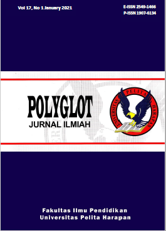THE ADULT-CHILD DYAD AS A PROBLEM-SOLVING SYSTEM: AN EXPERIMENT WITH ONE BILINGUAL INDONESIAN CHILD
DOI:
https://doi.org/10.19166/pji.v17i1.2432Trefwoorden:
adult-child dyad, zone of proximal development, interpsychological, intrapsychological, scaffolding, gaze behaviourSamenvatting
This study tries to reveal how the transition from interpsychological to intrapsychological functioning happens in an adult-child dyad’s activity involving a 3.6 year-old-child and the child’s mother. The study explores how the adult and child divided up the strategic responsibilities for carrying out a problem-solving task of completing a puzzle. The experiment, which took place in the child’s living room and lasted for 48 minutes, was videotaped and observed while all utterances by the adult and child were transcribed verbatim. Coding was done in order to note information showing the gaze behavior, interventions from the adult, and episodes for each correct match. Thematic analysis was chosen as the method to analyze the transcripts in order to find meaningful patterns. The study found that the adult’s intervention is important in the early stage of the joint-problem activity while, when the child takes more responsibility and develops some strategies as the child becomes more self-regulated, the adult’s role in scaffolding decreases. There is a transition from the interpsychological to intrapsychological functioning in the adult-child dyad while gazes towards the played cards outweigh the role of gazes towards other objects.
Referenties
Braun, V., & Clarke, V. (2006). Using thematic analysis in psychology. Qualitative Research in Psychology, 3(2), 77-101. https://doi.org/10.1191/1478088706qp063oa
Chaiklin, S. (2003). The zone of proximal development in Vygotsky’s analysis of learning and instruction. In A. Kozulin, B. Gindis, V. Ageyev, & S. Miller (Eds.), Vygotsky’s Educational Theory in Cultural Context. Cambridge, MA: Cambridge University Press. https://doi.org/10.1017/cbo9780511840975.004
Daniels, H. (2001). Vygotsky and pedagogy. London, UK: RoutledgeFalmer.
Daniels, H. (2015). Mediation: An expansion of the socio-cultural gaze. History of the Human Sciences, 28(2), 34-50. https://doi.org/10.1177/0952695114559994
Hedegaard, M. (2012). Analyzing children’s learning and development in everyday settings from a cultural-historical wholeness approach. Mind, Culture, and Activity, 19(2), 127-138. https://doi.org/10.1080/10749039.2012.665560
Meadows, S. (2018). Understanding child development: Psychological perspectives and applications. New York, NY: Routledge.
Mercer, N., & Littleton, K. (2007). Dialogue and the development of children’s thinking: A sociocultural approach. New York, NY: Routledge.
Minick, N. (1987). The development of Vygotsky’s thought: An introduction to thinking and speech. In H. Daniels (Ed.), Introduction to Vygotsky. London, UK: Routledge. https://doi.org/10.4324/9781315647654-2
Nilholm, C., & Säljö, R. (1996). Co-action, situation definitions and sociocultural experience: An empirical study of problem-solving in mother-child interaction. Learning and Instruction, 6(4), 325-344. https://doi.org/10.1016/s0959-4752(96)00019-9
Pacifici, C., & Bearison, D. J. (1991). Development of children’s self-regulations in idealized and mother-child interactions. Cognitive Development, 6(3), 261-277. https://doi.org/10.1016/0885-2014(91)90039-g
Rogoff, B. (1990). Apprenticeship in thinking. New York, NY: Oxford University Press, Inc.
Vygotsky, L. S. (1978). Mind in society: The development of higher psychological processes. Cambridge, MA: Harvard University Press.
Wertsch, J. V., McNamee, G. D., Mclane, J. B., & Budwig, N. A. (1980). The adult-child dyad as a problem-solving system. Child Development, 51(4), 1215-1221. https://doi.org/10.2307/1129563
Wertsch, J. V. (1984). The zone of proximal development: Some conceptual issues. New Directions for Child and Adolescent Development, 1984(23), 7-18. https://doi.org/10.1002/cd.23219842303
Wertsch, J. V. (1985). Vygotsky and the social formation of mind. Cambridge, MA: Harvard University Press.
Wertsch, J. V., Cole, M., & Daniels, H. (2007). The Cambridge companion to Vygotsky. Cambridge, MA: Cambridge University Press.
Wood, D., Bruner, J. S., & Ross, G. (1976). The role of tutoring in problem solving. Journal of Child Psychology and Psychiatry, 17(2), 89-100. https://doi.org/10.1111/j.1469-7610.1976.tb00381.x
Zuckerman, G. (2007). Child-adult interaction that creates a zone of proximal development. Journal of Russian & East European Psychology, 45(3), 43-69. https://doi.org/10.2753/rpo1061-0405450302##submission.downloads##
Gepubliceerd
Nummer
Sectie
Licentie
Authors who publish with this journal agree to the following terms:
1) Authors retain copyright and grant the journal right of first publication with the work simultaneously licensed under a Creative Commons Attribution License (CC-BY-SA 4.0) that allows others to share the work with an acknowledgement of the work's authorship and initial publication in this journal.
2) Authors are able to enter into separate, additional contractual arrangements for the non-exclusive distribution of the journal's published version of the work (e.g., post it to an institutional repository or publish it in a book), with an acknowledgement of its initial publication in this journal.
3) Authors are permitted and encouraged to post their work online (e.g., in institutional repositories or on their website). The final published PDF should be used and bibliographic details that credit the publication in this journal should be included.





